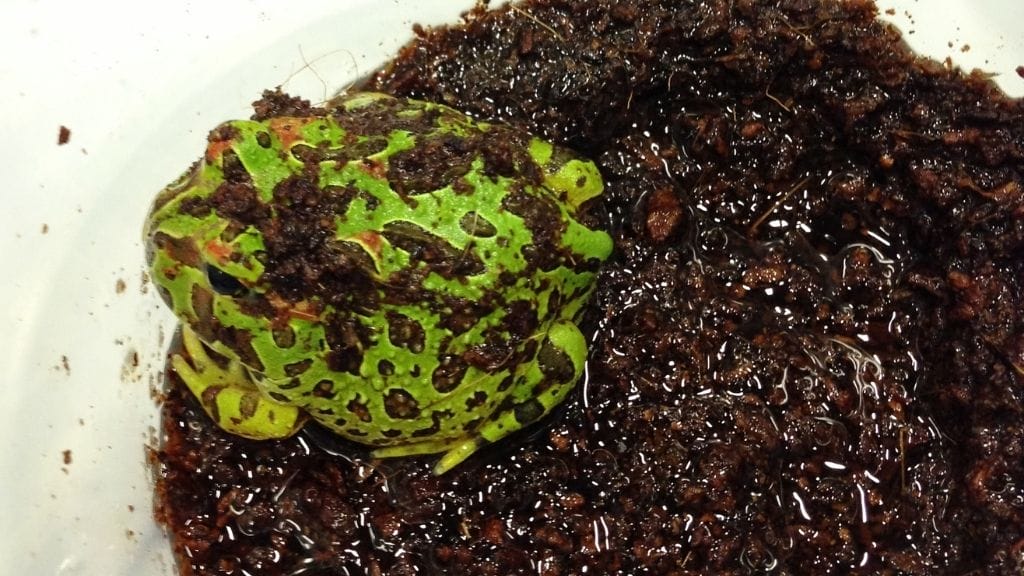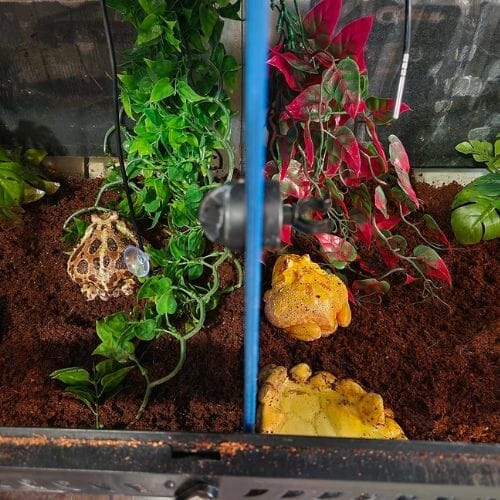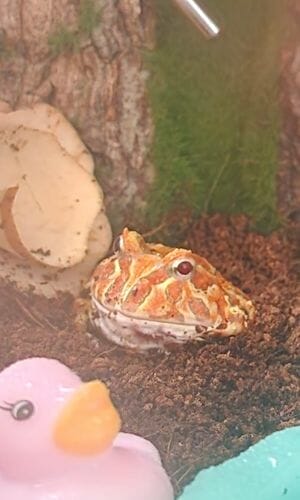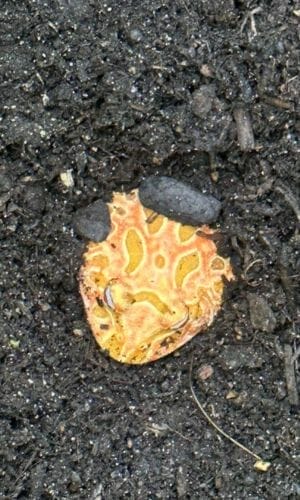Why Is My Pacman Frog Burrowing?

If you’re a beginner Pacman frog owner, seeing your frog burrowing can be a new experience for you. You might be wondering and asking everyone – why is my Pacman frog burrowing? Hence, I’ve conducted some researches to have a clear idea about this.
Generally, Pacman frog tends to burrow if the habitat is too dry or cold. The improper moisture level is a big reason behind this. Also, your Pacman frog can burrow to escape from the exposure of bright lightings. Moreover, Pacman frogs burrow themselves when they are stressed.
You must have other curiosity and questions in your mind regarding your Pacman frog burrow. In this article, I’ve explained all probable reasons, what to do, and other information. For this, I urge you to go through this article without any further ado.
Is It Normal For Pacman Frogs To Burrow?
You might have seen your Pacman frogs burying themselves completely. Sometimes, they may not even move a bit. So, this is pretty natural for a new owner of Pacman frogs to be worried.
It is normal for Pacman frogs to burrow. You can consider it as a part of their natural behavior. Rather, it’ll be abnormal if your Pacman frogs do not burrow themselves.
There are several reasons behind the Pacman frogs’ burrowing. Let’s get to know those reasons to confirm it entirely normal for Pacman frogs.
Why Is My Pacman Frog Burying Himself?
As I stated that it’s normal for Pacman frogs to burrow, you might be interested to know the reasons. There are some factors for which a Pacman frog buries himself. Such as-
- Being Shy
- Temperature And Moist Control
- Hunting Preys
- Estivation
- Preparing To Poop
- Getting Out Of The Light
- Comfort Zone
Now, let’s go through the details of these factors.
Being Shy
When you bring or adopt Pacman frogs, you may notice that they burrow frequently. This also happens when they shift into new habitats.
So, you can say that Pacman frogs burrow themselves because of not being comfortable. Many experienced owners have confirmed that they are very shy. Thus, they need some time to get easy with their new owner.
Hence, don’t worry if your new Pacman frog buries himself frequently. They’ll do it until they get comfortable around you.
Temperature And Moist Control
This is a significant reason for Pacman frogs’ burrowing. In another way, you can name it as their cooling-off process.
In the wild, the Pacman frogs usually live in humid weather. So, the ideal temperature for your Pacman frogs is around 75-85 degrees Fahrenheit during the day. Again, the temperature of around 65-75 degrees Fahrenheit will be perfect at night.
During the daytime, the temperature of the terrarium can get higher. That’s why the Pacman frogs tend to burrow when the temperature is high.
Also, you might have known that Pacman frogs breathe through their skin. On the other hand, moist substrate helps these frogs breathe normally.
So, even if they burrow under the substrate to cool off, they do not have to struggle to breathe.
Again, maximum Pacman frogs come out when the temperature gets low. Usually, the temperature falls at night. Hence, you might notice your frogs getting out at night-time.
Hunting Preys
A pretty popular tag for Pacman frogs is ‘ambush predators’ Almost all species of Pacman frogs just sit and wait for their prey. Then, they attack their prey shockingly and swallow.
Pacman frogs love to hide and burrow because burrowing makes them less visible to their potential prey. As a result, they can attack their prey when the prey comes near to them.
In the wild, Pacman frogs tend to burrow to escape the sight of their predators. But, they do not have to bother about any predators in the terrarium.
So, you can say that being ambush predators is another reason for their burying themselves.
Estivation
If you notice the cloudy and shell-like skin of your Pacman frogs, the reason for burying is shedding their skin.
Many amphibians and reptiles shed their skin. Pacman frogs also shed their skin and eat their shed skin. It’s completely natural.
This term is called estivation, just like another hibernation. Usually, Pacman frogs estivate when the temperature is too hot or too cold for them.
There are also other reasons for shedding skin. But, your Pacman frogs will burrow themselves whenever they are ready to shed their skin.
Preparing For Poop
Many experienced Pacman frog keepers have confirmed this. Sometimes, Pacman frogs burrow under the substrate while being prepared to poop. After finishing, they get out from burrowing easily.
Getting Out Of The Light
Some species of Pacman frogs become stressed by bright lighting. You must have known that they are pretty shy and sensitive creatures.
Excessive bright lighting can put stress on your Pacman frog. If you notice that your frog has stopped eating with burrowing, the lighting is the actual reason behind these. For getting out of the light, your Pacman frog burrows himself.
Comfort Zone
If you don’t find any fit reason behind their burrowing, leave all of your thoughts. Probably, your Pacman frogs burrow themselves just because of making a comfort zone. Otherwise, you can say that they love to burrow simply because of being a Pacman frog.
After all, what else can you expect from this shy creature?
How Deep Do Pacman Frogs Bury Themselves?
Sometimes, you may notice their horns sticking out outside the substrate while their entire body is burrowed. Again, your Pacman frogs might bury themselves completely.
You may not even find your frogs because they bury themselves too deep. So, it’s a common question that how deep Pacman frogs bury themselves.
Many researches have shown that Pacman frogs can bury themselves up to five inches. They tend to burrow until they find a moist layer of the substrate.
If the temperature is too high, Pacman frogs bury themselves more deep down. The same thing goes for in case of the dry substrate.
Pacman frogs may want to cool them off. So, they bury themselves deep down in the level where they find comfort.
How Long Do Pacman Frogs Bury Themselves?
There is no specific limit or rule for this. As the reasons for Pacman frog’s burrow vary, the time-spans of staying buried vary in the same way.
Some owners shared their experiences where Pacman frogs stay buried for several days. In short, you can say that Pacman frogs can stay buried as long as they do not become hungry. If your frog gets a good feeding, he can keep himself buried for a long time.
Again, some Pacman frogs take a few weeks to get out. Even some Pacman frogs bury themselves for a month-long.
For your wonder, a baby Pacman frog can also burrow himself entirely for a few days. Remember that complete burrow of baby Pacman frog, for a long time, is fine too.
There is nothing to worry about if your Pacman frog keeps himself buried for a long time. Because this is a pretty natural thing for them as long as your frog is healthy. So, all you need to do is misting their substrate often.
Should I Dig Up My Pacman Frog?
If your Pacman frog keeps himself buried for a long time, you may think to dig it up. But, before digging up your Pacman frog, you need to check some factors.
The most important thing to notice is if your Pacman frog is showing any health issues or not. If there are no such signs to worry about, you can dig up your frog.
For example, your Pacman frog burrowed himself for 3-4 days after having a good feeding. If you notice no visible health issues, dig up your Pacman frog.
Then, feed him well. Give him a bath and an opportunity to poop also. After eating, your Pacman frogs may keep burrowing themselves again and again. You can also dig him up each time in the same way.
Again, if your Pacman frog keeps himself buried and his skin is harder, he must be into estivate. In this time, handling your Pacman frog can put him under stress. Hence, you must not dig him up in such a situation to avoid any harm to his health.
Rather, let him stay buried under the substrate. Your frog will come out on his own when his situation gets improved.
Why Do My Pacman Frogs Not Burrow?
Some people think that Pacman frogs must burrow often. But, you may have an entirely different experience with your pet Pacman frogs. So, it may be a little bit concerning for you why your Pacman frogs do not burrow!
It’s completely normal if your Pacman frogs do not burrow. In case your Pacman frogs do not burrow, they are probably comfortable with their terrarium environment.
Usually, these frogs burrow deeper in the substrate to cool themselves off. If they aren’t comfortable with the temperature and humidity of the terrarium, they start burrowing. Otherwise, getting out of the light can be the reason.
So, why would your Pacman frog bury himself if he finds everything comfortable in his terrarium! Not burrowing means the humidity, temperature, and lighting of the terrarium are pretty appealing to your frogs.
How To Ensure A Burrow-Friendly Habitat For Your Pacman Frog?
Some Pacman frog keepers do not want their frogs to burrow. On the other hand, some owners enjoy while their Pacman frogs are burrowing.
So, you need to ensure that your Pacman frog feels comfortable whether being buried or not. To ensure a burrow-friendly habitat for your Pacman frog, you need to follow some rules.
Such as-
- You must ensure that the humidity of the terrarium is always around 80%. Otherwise, their skin will get dry, and the estivation will prolong.
- Keep the temperature around 75-88 degrees Fahrenheit of the terrarium of the Pacman frog.
- You’ve to make sure that the lighting in the terrarium isn’t too bright. If you use a UVB light for the Pacman frog terrarium, make sure that it’s only for 12 hours.
- You can also cover the sides of their terrarium to reduce access to daylight. This’ll help Pacman frogs not to get stressed out easily.
- Provide a good substrate of at least 3 inches deep. This will help your Pacman frog feel safe and comfortable to burrow deeper.
- Make sure that the substrate is moist. Otherwise, Pacman frogs won’t burrow even if they want to burrow. But, don’t make the substrate soaking wet.
- Again, do not forget to keep the entire terrarium clean.
- Instead of using a tong, leave the live preys. Their movements will entice your frogs to eat them.
Frequently Asked Questions
Do pacman frogs hibernate?
Pacman frogs can hibernate. However, the more appropriate term is estivation.
Pacman frogs will hide as much as they can during estivation, trying to gain moisture from the substrate. Additionally, they will stay there for long periods of time, mostly sleeping.
Pacman frogs under a year of age should not be allowed to estivate. Maintaining high humidity and temperature levels can reduce the risk of your frog going into estivation while in captivity.
Why pacman frog buried itself completely?
Pacman frogs bury themselves completely as an instinctive behavior to hunt or escape predators.
Staying out of sight and only emerging when their prey is in view is a common behavior observed in Pacman frogs. Burrowing is also common when they are shedding.
Pacman frogs can bury themselves up to five inches to get away from heat and light, or to reach the moist substrate. In some cases, Pacman frogs may also bury themselves to avoid ingesting substrate while feeding.
Pacman frog not burrowing: should I be worried?
If your Pacman frog is not burrowing, there is no need to worry as long as it is displaying other healthy behaviors.some Pacman frogs may not burrow as frequently or as deeply as others.
However, if your frog is not burrowing and is displaying other signs of illness such as lethargy, loss of appetite, or difficulty breathing, it may be a cause for concern. In such cases, it is recommended that you seek advice from a veterinarian who specializes in treating amphibians.
How to tell if pacman frog is stressed?
There are several signs that can indicate if a Pacman frog is stressed. Some common signs of stress in Pacman frogs include:
1. Hiding or burrowing more often than usual
2. Refusing to eat or eating less than usual
3. Jumping or trying to escape from the enclosure
4. Lethargy or lack of movement
5. Changes in skin color or texture
6. Rapid breathing or panting
Handling Pacman frogs can also cause them stress, so it is generally not recommended unless it is necessary. If you suspect that your Pacman frog is stressed, it is important to identify and address the source of the stress to prevent further stress to your pacman frog.
Why is my pacman frog not moving?
There could be several reasons why your Pacman frog is not moving. Some possible reasons include:
Temperature conditions: If the temperature in the enclosure is too low or too high, your Pacman frog may become sluggish and stop moving. Ensure that the temperature in the enclosure is within the recommended range for your frog species.
Health issues: Pacman frogs can develop health issues such as infections, parasites, or injuries that can cause them to stop moving. If you suspect that your frog is sick, it is recommended that you take it to a veterinarian who specializes in treating amphibians.
Stress: As mentioned earlier, stress can cause Pacman frogs to stop moving. Ensure that the enclosure is set up correctly and that your frog has adequate hiding places to reduce stress.
Hibernation: Pacman frogs may go into hibernation or estivation, which can cause them to stop moving for extended periods. However, this behavior is more common in adult frogs and is not recommended for juvenile frogs.
If your Pacman frog is not moving, it is recommended that you monitor its behavior closely and seek advice from a veterinarian if you suspect that it is sick or injured.
How often do pacman frogs shed?
Pacman frogs can shed every day to once every couple of weeks, and the frequency of shedding depends on the age and species of the frog.
Some Pacman frog species shed more frequently than others. The shedding process usually takes a few days, and the frog will shed in one piece, which they will often eat.
Final Words
As a Pacman frog keeper, it’s fun to see the Pacman frog burrow activities. I hope this article has helped you understand the basic guidelines. Just make sure that your Pacman frog isn’t having any health issues while burrowing quite often in their substrate.
About Author
Hello, I’m Muntaseer Rahman, the owner of AcuarioPets.com. I’m passionate about aquarium pets like shrimps, snails, crabs, and crayfish. I’ve created this website to share my expertise and help you provide better care for these amazing pets.
Disclaimer
This site is owned and operated by Muntaseer Rahman. AcuarioPets.com is a participant in the Amazon Services LLC Associates Program, an affiliate advertising program designed to provide a means for sites to earn advertising fees by advertising and linking to Amazon.com. This site also participates in other affiliate programs and is compensated for referring traffic and business to these companies.







